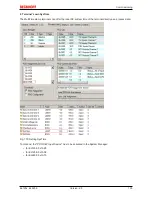
Commissioning
EL125x, EL2258
122
Version: 2.5
6.5.2
Commissioning of a MTI channel
1. Synchronous or asynchronous operation?
•
Synchronous
(default): Synchronous operation should be selected if events are to be transferred from
the channel to the controller as quickly as possible.
- In each EtherCAT cycle as many events as possible are loaded into the buffer. The number of events
per channel can be read via
EventsInInputBuffer
. The maximum number of events that can be stored is
32.
- The MTSF is used to specify how many events per cycle are transferred from the buffer into the
process data. The factor is currently limited to a maximum of 10.
- If the number of new events consistently exceeds the MTSF value, the buffer may overflow. Via the
CoE 0x80n0:13
the behavior on buffer overflow can be configured for each channel.
•
Asynchronous:
If high data integrity is required, asynchronous handshake operation should be
selected.
Application from the PLC:
- The channel signals the presence of data with
NoOfInputEvents
> 0
- The PLC can accept the data (input event states and timestamps).
- The
InputOrderCounter
has to be incremented (+ 1)
- In the next cycle the
InputOrderFeedback
should have assumed the value of the
InputOrderCounter
- If further events are present in the buffer, they are shown in the process image.
- Starting from the beginning...
Fig. 154: Setting in CoE x80n0:12 Asynchronous operation
2. Setting the multi-timestamping factor (MTSF)
To facilitate choosing an appropriate MTSF one should estimate the frequency at which level changes, i.e.
events, are expected at the input. The multi-timestamping factor (MTSF) can then be selected. The factor
indicates how many events per cycle are transferred from the buffer to the controller. With asynchronous
transfer one should note that, due to the handshake, only half the number of events are retrieved per time
period.
In order to avoid the transfer of excessive quantities of process data, the following configuration
recommendations apply:
Synchronous transfer:
MTSF ≥ (expected maximum number of input events per EtherCAT cycle) + 1
Asynchronous transfer
MTSF ≥ 2x (expected maximum number of input-events per EtherCAT cycle) + 1
Example:
At a cycle time of 1 ms, a maximum of 4 events/ms per channel are expected. All 8 channels of
the EL1258 are to be used.
- Synchronous transfer: MTSF
≥
5
Select "Multi-Timestamping 8 Ch. 5x" via the predefined PDO. If a somewhat larger number of events then
occur in a cycle, these are buffered in the channel buffer; the buffer can then be emptied by the controller in
the subsequent cycles.
Fig. 155: Process data selection (predefined PDO) for synchronous transfer
- Asynchronous transfer: MTSF
≥
9
Select "Multi-Timestamping 8 Ch. 10x" via the predefined PDO.
Fig. 156: Process data selection (predefined PDO) for asynchronous transfer
Содержание EL1258
Страница 2: ......
Страница 6: ...Table of contents EL125x EL2258 6 Version 2 5...
Страница 42: ...Mounting and wiring EL125x EL2258 42 Version 2 5 Fig 36 Other installation positions...
Страница 76: ...Commissioning EL125x EL2258 76 Version 2 5 Fig 86 Incorrect driver settings for the Ethernet port...
















































